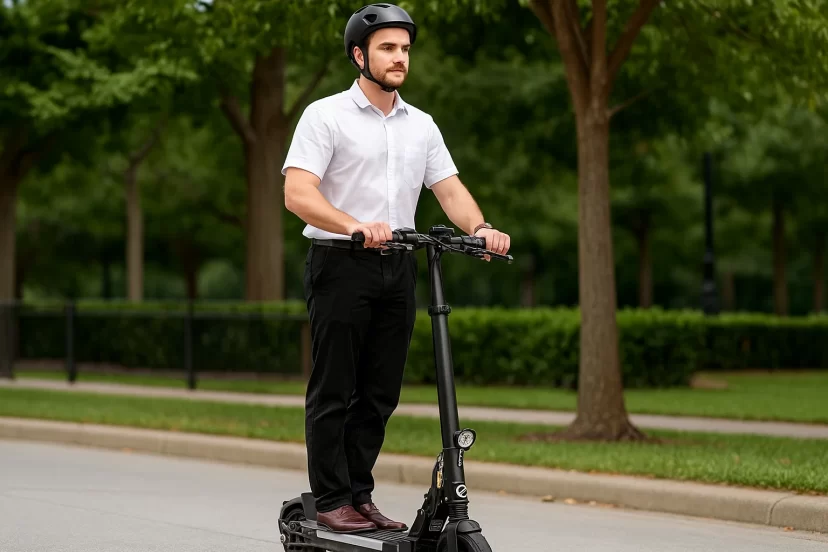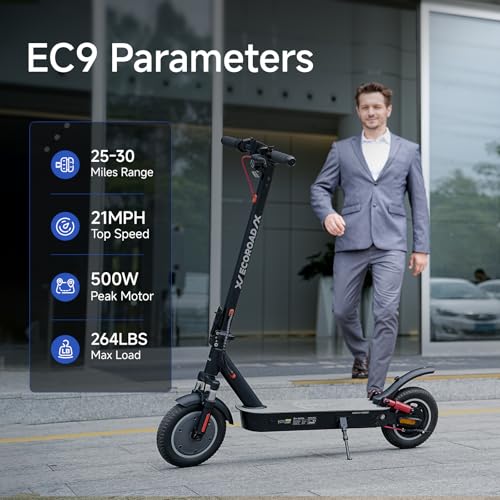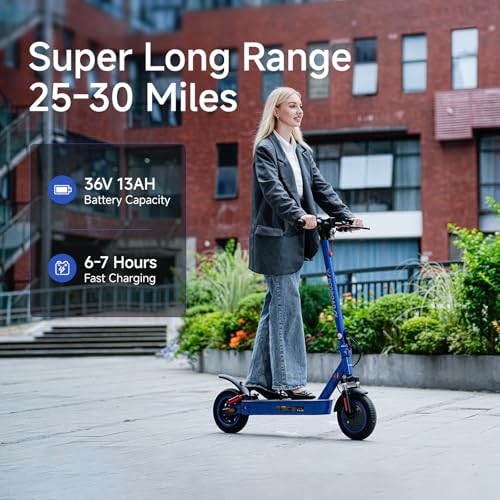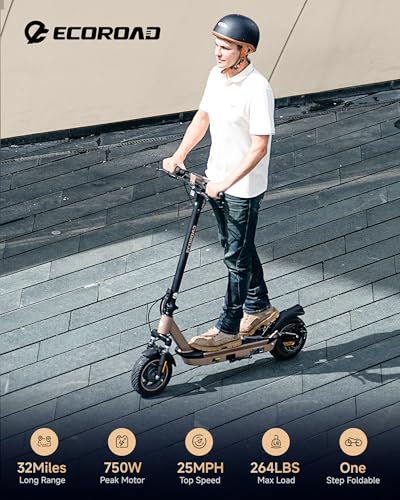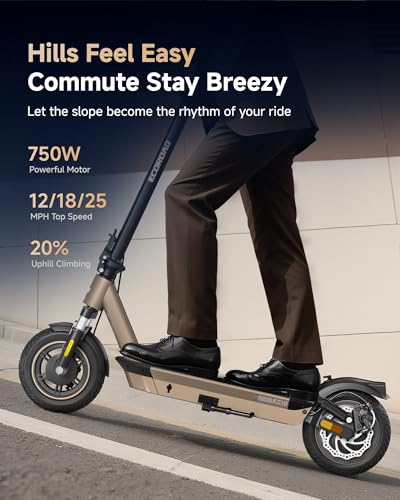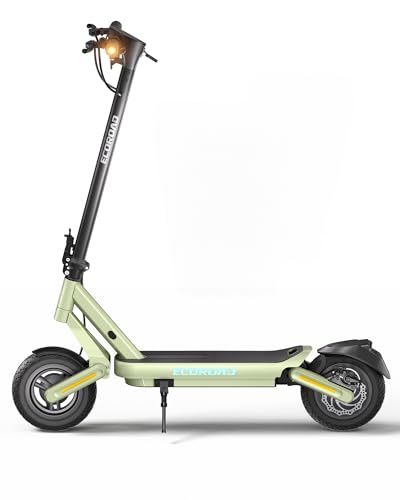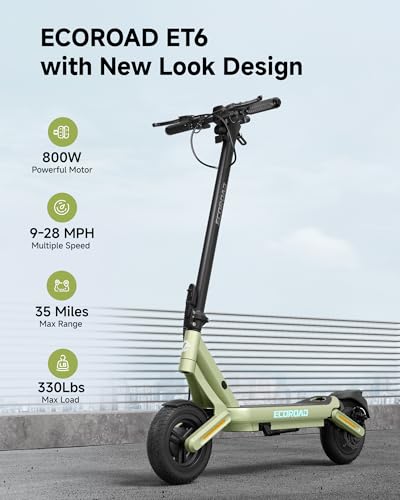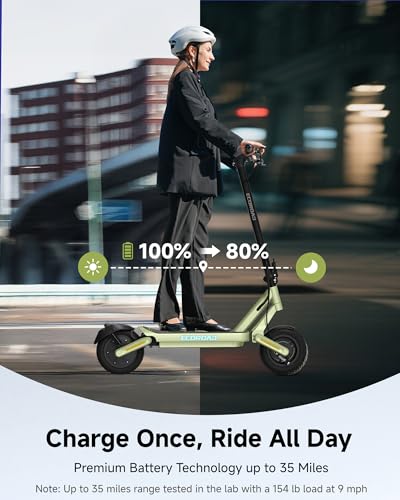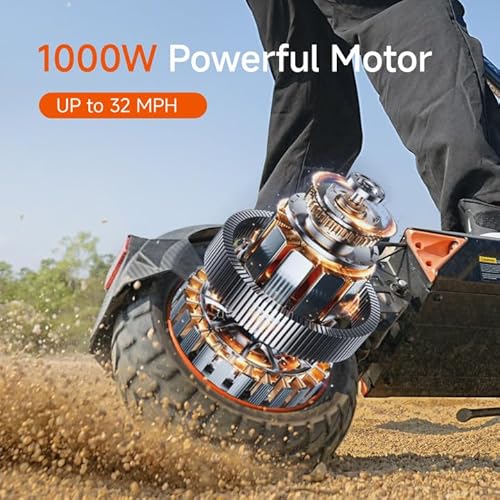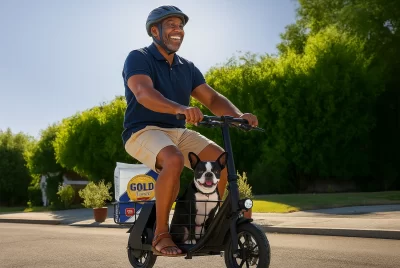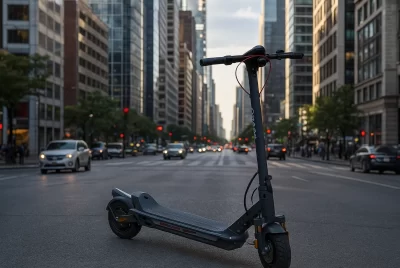ECOROAD Electric Scooter Review
*We may earn a commission for purchases made using our links. Please see our disclosure to learn more.
The daily grind of urban commuting takes a toll—wasted hours in traffic, expensive parking fees, and the constant stress of navigating congested streets. For those seeking an alternative, the ECOROAD electric scooter offers a solution that transforms the commute from a dreaded obligation into an efficient, enjoyable experience.
Urban transportation is undergoing a radical shift. Electric scooters have emerged as a practical answer to the challenges of modern city living, combining affordability, convenience, and environmental responsibility. The ECOROAD electric scooter stands at the forefront of this movement, delivering the performance and reliability that serious commuters demand while addressing real-world transportation obstacles.
“Electric scooters have transformed urban transportation by providing a practical, sustainable alternative that addresses the first and last mile problem while reducing congestion and emissions in city centers.”
— International Transport Forum, OECD
Key Takeaways
- Versatile Performance: ECOROAD electric scooters deliver reliable range and speed suitable for various urban commuting needs
- Cost-Effective Transportation: Significant savings compared to car ownership, parking fees, and public transit passes
- Environmental Impact: Zero emissions contribute to cleaner air quality in urban environments
- Practical Design: Foldable, portable construction makes storage and multi-modal commuting seamless
- Low Maintenance: Minimal upkeep requirements compared to traditional vehicles
Recommended ECOROAD Electric Scooter
ECOROAD EC9 Electric Scooter
Experience smarter, faster, and safer commuting with the ECOROAD Electric Scooter, engineered for adults who want comfort, performance, and reliability in a sleek foldable design. Powered by a 36V 13Ah high-capacity battery and an upgraded 500W brushless hub motor, this scooter delivers up to 30 miles per charge and speeds reaching 25 MPH—perfect for daily city travel, campus rides, or weekend cruising.
The ECOROAD EC9 Electric Scooter stands out in the adult commuter scooter category for its balance of power, comfort, and smart technology. Designed with a robust 500W brushless motor, the scooter accelerates quickly and maintains a stable top speed of up to 25 MPH, giving riders the ability to navigate busy city streets effortlessly. Its long-range 36V 13Ah battery supports up to 30 miles of travel, making it suitable for long commutes or multiple short trips without needing a recharge.
- Performance: Fast 25 MPH speed with a powerful 500W motor built for city commuting.
- Comfort: 10” solid tires + four shock absorbers for smooth, vibration-free riding.
- Smart Features: APP Lock, turn signals, and LED display enhance convenience and control.
- Weight: Slightly heavier compared to basic commuter scooters due to larger battery.
- No Pneumatic Tires: Solid tires avoid flats but may feel slightly stiffer on very rough terrain.
- Charging Time: High-capacity battery takes longer to fully recharge.
ECOROAD ES4 Electric Scooter
Meet the ECOROAD Electric Scooter ES4, a high-performance adult e-scooter engineered for riders who demand power, comfort, and smart functionality. Equipped with an 800–1000W motor, the ES4 reaches speeds up to 31MPH, giving you fast acceleration whether commuting or cruising. Its long-lasting battery delivers up to 31 miles of range, making it ideal for daily travel or weekend adventures.
The ECOROAD Electric Scooter ES4 is designed for riders who want a strong combination of speed, durability, and modern tech. Powered by an 800–1000W high-torque motor, the ES4 achieves a peak speed of 31MPH, making it suitable for fast commutes, long-distance travel, and even mild off-road usage. With its high-capacity battery, riders can enjoy up to 31 miles of dependable riding on a single charge.
- Motor Power & Speed: The ECOROAD Electric Scooter ES4 delivers 31MPH top speed with its 800–1000W motor.
- Range & Comfort: Up to 31 miles per charge with dual suspension and off-road tires.
- Smart Tech: App control, RGB lighting, cruise control, and instant folding.
- Weight: Durable heavy-duty build can be tiring to carry for long distances.
- Charging Time: Requires an overnight charge for maximum range.
- High Speed: 31MPH capability may feel overwhelming for beginners.
ECOROAD Electric Scooter ET6
Experience long-range power and premium comfort with the ECOROAD Electric Scooter ET6, designed for commuters who value reliability, style, and performance. Powered by an 800W high-efficiency motor, the ET6 reaches speeds up to 28MPH and delivers an impressive 35-mile range on a single charge—perfect for long daily commutes or weekend rides.
The ECOROAD Electric Scooter ET6 is built for commuters who want a reliable, long-distance electric ride with premium comfort and smart features. With an 800W motor, the ET6 provides strong acceleration and reaches a top speed of 28MPH, making it suitable for both urban environments and longer open-road travel. Its high-capacity battery delivers an impressive 35-mile range, allowing riders to complete full-day commutes without worrying about charging.
- Long Range: Up to 35 miles per charge, ideal for extended commutes.
- Smooth Ride: Dual suspension + 10" air tires minimize vibrations on rough terrain.
- Smart & Safe: LED headlight, turn signals, RGB lights, app locking, and cruise control.
- Charging Duration: Full charge may take several hours for long-range capability.
- Weight: Sturdy aluminum frame adds heaviness when carrying upstairs.
- Speed Cap: Top speed is limited to 28MPH, lower than some high-performance models.
ECOROAD Electric Scooter ET8
Experience unmatched power, range, and comfort with the ECOROAD Electric Scooter ET8. Engineered for serious commuters and adventure riders, the ET8 is powered by a 1000W high-efficiency motor and a 48V 20Ah battery, delivering up to 50 miles per charge. Its 10-inch premium air-filled off-road tires and dual swing-arm suspension ensure smooth rides over diverse terrain, absorbing bumps and vibrations for total comfort.
The ECOROAD Electric Scooter ET8 is designed for riders who demand long-range performance, comfort, and advanced smart features. Powered by a 1000W high-efficiency motor and a 48V 20Ah battery, the ET8 offers up to 50 miles of worry-free travel, leaving range anxiety behind. Its 10-inch air-filled off-road tires and dual front & rear swing-arm suspension provide smooth, stable rides across urban streets, rough paths, or off-road trails.
- Long Range & Power: Up to 50 miles on a single charge with a 1000W motor.
- Comfortable Ride: Dual swing-arm suspension and adjustable plush seat for smooth journeys.
- Smart & Safe: Color display, Bluetooth, cruise control, 360° lighting, and dual disc brakes.
- Weight: Sturdy build adds bulk for carrying or storage.
- Charging Time: Full battery may take several hours to recharge.
- Size: Larger footprint may be challenging in tight spaces or public transport.
The Journey Toward Smarter Commuting
The decision to embrace electric scooter commuting often emerges from frustration with traditional transportation methods. Rising gas prices, parking nightmares, and the environmental toll of single-occupancy vehicles create a perfect storm that pushes urban residents to seek alternatives. The ECOROAD electric scooter addresses these pain points head-on.
For many riders, the transformation begins with a simple calculation: how much time and money gets wasted on conventional commuting? When factoring in vehicle payments, insurance, fuel, maintenance, and parking, the numbers become staggering. A reliable electric scooter can pay for itself within months through transportation savings alone.
Breaking Down Mental Barriers
The initial hesitation is real. Questions flood in: Is it safe? Will it handle my commute distance? What happens when it rains? Can it tackle hills? These concerns represent genuine obstacles that every prospective rider must overcome.
Safety concerns often top the list. The learning curve for operating an ECOROAD electric scooter proves surprisingly gentle. Most riders achieve confidence within their first few trips, discovering that the intuitive controls and stable platform make navigation straightforward. The key lies in starting slowly—practicing in low-traffic areas, mastering acceleration and braking, and gradually building skills before tackling busy streets.
Weather considerations require honest assessment. While electric scooters excel in dry conditions, wet weather demands extra caution. Reduced tire traction and visibility challenges mean adjusting riding style or choosing alternative transportation during heavy precipitation. However, light rain and damp conditions remain manageable with appropriate tire tread and cautious speed management.
The Physical and Emotional Transformation
Rediscovering the Joy of Movement
Something remarkable happens when daily commuting shifts from passive sitting to active riding. The ECOROAD electric scooter creates an engaging travel experience that awakens senses dulled by years of automobile cocooning. Suddenly, the route to work becomes an opportunity to observe neighborhood details previously missed—the changing seasons reflected in tree leaves, the rhythm of city life unfolding, the satisfaction of efficient movement.
This sensory richness extends beyond mere observation. The slight physical engagement required—maintaining balance, steering through traffic, adjusting to road conditions—keeps the mind alert and present. Unlike the zombie-like state induced by monotonous driving or mindless transit riding, scooter commuting demands presence. This active participation transforms mundane travel into an experience worth having.
The Ripple Effects on Daily Life
The benefits radiate outward in unexpected ways. Arriving at work energized rather than exhausted changes how the entire day unfolds. That first meeting feels less daunting when starting from a positive mental space. Productivity increases when not recovering from traffic-induced stress. Mood improvements become noticeable to colleagues and family members.
Physical health improvements emerge gradually. While electric scooters provide motor assistance, they still require core engagement, balance work, and occasional foot pushing. These micro-movements accumulate throughout regular commutes, contributing to overall fitness levels without demanding dedicated gym time. The outdoor exposure provides vitamin D and fresh air—simple benefits that desk-bound workers desperately need.
Financial wellness improves alongside physical health. The money previously allocated to gas, parking, and vehicle maintenance becomes available for other priorities. Some riders discover they can downsize to a single household vehicle or eliminate car ownership entirely. These savings compound over time, creating financial breathing room that reduces overall stress levels.
Overcoming Common Challenges
Range Anxiety and Planning
One of the most significant hurdles facing new electric scooter riders involves range anxiety—the fear of running out of battery mid-journey. The ECOROAD electric scooter addresses this concern through reliable battery performance, but anxiety persists until riders develop confidence through experience.
The solution involves methodical planning during the transition period. Start by accurately measuring commute distances and comparing them against the scooter’s stated range. Factor in a safety margin of at least 20% to account for battery degradation, hills, wind resistance, and cold weather impacts. Most riders discover their actual range exceeds their needs, but this verification process builds essential confidence.
Charging logistics require establishing new routines. Unlike gas stations accessible throughout every journey, electric scooter charging happens at fixed locations—primarily home and potentially work. Successful riders develop consistent charging habits, plugging in nightly regardless of battery level to ensure full capacity each morning. Some workplaces provide charging stations or accessible outlets, extending range possibilities for longer commutes.
Storage and Security Concerns
The portability that makes ECOROAD electric scooters attractive also creates vulnerability. Theft prevention requires vigilant attention and smart strategies. Folding capability enables bringing scooters indoors at destinations, eliminating theft risk entirely when practical. For situations requiring outdoor parking, heavy-duty locks prove essential—cable locks alone provide insufficient protection against determined thieves.
Home storage presents its own considerations. Apartments and small living spaces challenge riders to find suitable scooter parking. The folding mechanism helps, but weight and dimensions still demand floor space. Creative solutions include hallway corners, bedroom closets, or balcony storage when weather permits. Some riders negotiate with building management for dedicated scooter parking areas.
Workplace storage varies dramatically by employer. Progressive companies embrace alternative transportation by providing secure indoor parking areas for bikes and scooters. Others require negotiation or improvisation. Keeping the scooter at your desk, in a break room, or in a locked closet protects your investment while demonstrating commitment to sustainable commuting.
Weather and Seasonal Adaptation
The romance of year-round scooter commuting meets reality when facing harsh weather conditions. Rain, snow, extreme heat, and bitter cold each present unique challenges requiring adaptation strategies. ECOROAD electric scooter riders in temperate climates enjoy advantages over those facing severe seasonal swings, but everyone encounters less-than-ideal conditions eventually.
Rain riding demands respect and preparation. Waterproof clothing keeps riders dry, but wet road surfaces require reduced speeds and increased following distances. Braking distances extend on wet pavement, and metal surfaces like manhole covers become treacherously slippery. Puddle depths prove deceptive—what appears shallow might hide wheel-swallowing potholes. Many riders establish personal rain thresholds beyond which alternative transportation becomes the wiser choice.
Cold weather impacts both rider comfort and battery performance. Lithium batteries lose capacity in freezing temperatures, sometimes reducing range by 20-40%. Layered clothing, insulated gloves, and face protection maintain rider warmth, but exposed skin suffers in sub-freezing winds generated by travel speeds. Some dedicated riders continue through winter, while others acknowledge seasonal limitations and maintain backup transportation options.
Building Skills and Confidence
The Learning Progression
Mastery of ECOROAD electric scooter operation follows a predictable progression. Initial rides feel awkward and nerve-wracking. The acceleration seems too sensitive, the brakes too aggressive, the steering too responsive. Within a few sessions, these same characteristics become advantages—the quick acceleration merges traffic efficiently, the strong brakes provide safety margins, the responsive steering navigates obstacles gracefully.
Intermediate riders develop situational awareness that novices lack. The ability to scan ahead for hazards, anticipate traffic patterns, and position strategically in lanes emerges through accumulated experience. Reading road surfaces becomes automatic—spotting gravel patches, drainage grates, expansion joints, and other hazards before they pose problems.
Advanced riders flow through urban environments with practiced efficiency. Route selection incorporates factors beyond mere distance: traffic patterns, road surface quality, hill profiles, and scenic value all influence choices. These experienced commuters know which streets offer bike lanes, which intersections prove dangerous, and where aggressive drivers congregate.
City navigation on an ECOROAD electric scooter differs fundamentally from car-based travel. Riders gain access to bike paths, greenways, and shortcuts unavailable to automobiles. This expanded route network often enables faster point-to-point travel than cars manage during congested periods.
Understanding traffic law application to electric scooters proves essential. Regulations vary by jurisdiction—some cities classify scooters as bicycles, others as motorized vehicles, and some maintain ambiguous rules. Responsible riders research local laws regarding sidewalk usage, bike lane access, speed limits, and equipment requirements. This knowledge prevents citations and reduces conflict with pedestrians, cyclists, and drivers.
Defensive riding techniques protect against accidents. Assuming invisibility to drivers eliminates dangerous assumptions about being noticed. Making eye contact with drivers before crossing their paths confirms awareness. Claiming lane space when necessary prevents dangerous squeeze situations. Avoiding the door zone along parked cars prevents collision with opening doors. These techniques, learned through education and experience, dramatically improve safety outcomes.
The Environmental and Community Impact
Contributing to Cleaner Cities
Every ECOROAD electric scooter trip replacing a car journey contributes to improved air quality. While individual impact seems negligible, collective adoption creates measurable differences. Cities with strong scooter adoption report reduced traffic congestion, lower emissions, and improved public health outcomes.
The environmental calculus extends beyond zero tailpipe emissions. Manufacturing impacts, electricity generation sources, and battery disposal all factor into total environmental footprint. However, lifecycle analyses consistently demonstrate electric scooters’ superior sustainability compared to conventional vehicles. The relatively small battery size, efficient electric motors, and lightweight construction minimize resource consumption per mile traveled.
Noise pollution reduction represents an often-overlooked benefit. Electric motors operate nearly silently compared to internal combustion engines. Streets filled with electric scooters, bikes, and pedestrians instead of rumbling vehicles create calmer, more pleasant urban environments. This acoustic improvement enhances quality of life for residents and workers throughout affected neighborhoods.
Building Community Connections
The ECOROAD electric scooter community extends beyond individual riders to encompass a growing movement of sustainable transportation advocates. Online forums, social media groups, and local meetups connect riders for knowledge sharing, group rides, and advocacy efforts. These connections combat the isolation often experienced by early adopters trying something unconventional.
Sharing experiences helps newcomers overcome obstacles that might otherwise prove insurmountable. Questions about specific routes, maintenance procedures, or legal issues receive answers from experienced community members. Product recommendations, modification ideas, and safety tips flow freely among riders invested in each other’s success.
Advocacy efforts amplify through collective action. Rider groups pressure city governments to improve infrastructure, expand bike lane networks, and create scooter-friendly regulations. This grassroots organizing gradually transforms urban environments to better accommodate alternative transportation. Individual riders benefit from improvements secured through community organizing.
Practical Maintenance and Longevity
Establishing Maintenance Routines
ECOROAD electric scooters require minimal maintenance compared to automobiles, but neglect still causes problems. Simple routines prevent minor issues from becoming major failures. Weekly visual inspections catch developing problems before they cause breakdowns or safety hazards.
Tire maintenance tops the priority list. Pneumatic tires require regular pressure checks—under-inflation causes poor handling and increased puncture risk. Solid tires eliminate puncture concerns but require inspection for wear patterns indicating alignment issues. Both types need periodic replacement when tread depth becomes inadequate.
Brake adjustment maintains stopping power as pads wear. Most electric scooters use disc brakes requiring occasional pad replacement and rotor cleaning. Electronic braking systems need less attention but still benefit from periodic inspection. Testing brakes regularly in controlled situations ensures they function properly when emergencies demand maximum stopping power.
Battery care determines long-term range and performance. Following manufacturer charging guidelines maximizes battery lifespan. Avoiding complete discharge cycles, storing at partial charge during extended non-use periods, and keeping batteries at moderate temperatures prevents premature degradation. These practices extend useful battery life by years.
Troubleshooting Common Issues
Flat tires rank as the most common ECOROAD electric scooter problem. Carrying basic tools and spare tubes enables roadside repairs, though many riders choose to walk their scooter home or to repair shops for more comfortable fix environments. Learning tube replacement saves money and reduces downtime when punctures inevitably occur.
Electronic gremlins occasionally plague even reliable scooters. Connection issues, sensor malfunctions, and controller glitches require systematic troubleshooting. Starting with the obvious—checking battery charge, verifying power switches, inspecting cable connections—resolves most issues. Persistent problems demand professional diagnosis, though online communities often provide valuable troubleshooting guidance.
Physical damage from crashes or rough handling requires honest assessment. Minor scratches and scuffs affect appearance but not function. Bent handlebars, damaged decks, or compromised frames demand immediate attention. Safety always outweighs cosmetic concerns—replacing damaged structural components prevents catastrophic failures that could cause serious injury.
Financial Considerations and Value Assessment
Calculating Total Cost of Ownership
The ECOROAD electric scooter purchase price represents only the beginning of financial considerations. Honest cost assessment includes accessories, maintenance, eventual repairs, and replacement timelines. However, even accounting for these expenses, scooter ownership typically costs far less than car alternatives.
Essential accessories add to initial investment. Quality helmets, lights for visibility, locks for security, and weather protection gear quickly accumulate costs. However, these one-time purchases provide long-term utility. Cheap helmets or inadequate locks prove false economies—investing in quality protective and security equipment pays dividends through enhanced safety and theft prevention.
Maintenance costs remain remarkably low for electric scooters. Tire replacements every few thousand miles, occasional brake pad changes, and rare component failures represent the typical expense profile. Setting aside a small monthly amount covers these needs without financial strain. Comparing these costs to car insurance premiums alone demonstrates massive savings potential.
Battery replacement eventually becomes necessary as capacity degrades over years of use. Quality batteries last 500-1000 charge cycles before losing significant capacity. For daily commuters, this translates to 2-4 years before replacement becomes desirable. Factoring this expense into ownership costs maintains realistic expectations while still demonstrating strong value compared to automotive alternatives.
Understanding Long-Term Value
The ECOROAD electric scooter delivers value extending beyond simple transportation cost savings. Time savings from avoiding traffic congestion and parking searches accumulate dramatically over months and years. Converting this recovered time into productive work, family engagement, or personal enjoyment multiplies the financial justification.
Health benefits contribute indirect financial value through reduced medical costs and improved productivity. Regular outdoor activity, stress reduction, and increased physical engagement all support better health outcomes. While difficult to quantify precisely, these benefits represent real value deserving consideration in purchase decisions.
Lifestyle enhancement defies easy financial calculation but matters tremendously to overall life satisfaction. The joy of efficient movement, environmental contribution satisfaction, and freedom from automotive burdens improve daily quality of life. These intangible benefits often prove more valuable than monetary savings to committed riders.
Route Planning and Optimization
Discovering Your Ideal Commute
The beauty of ECOROAD electric scooter commuting lies in route flexibility unavailable to car drivers. Initial route selection typically mirrors automotive paths, but experience reveals superior alternatives. Bike paths, park trails, and quiet residential streets often provide faster, safer, and more enjoyable travel than major thoroughfares.
Route reconnaissance during low-stress times builds knowledge for daily commutes. Weekend exploration identifies smooth pavement, discovers scenic shortcuts, and reveals potential hazards. This preparation prevents unpleasant surprises during time-pressured workday travel. Photographing or noting specific turns, landmarks, and potential problem areas aids memory during actual commutes.
Multiple route options provide flexibility for varying conditions. Direct routes minimize travel time during ideal weather and when running late. Scenic routes maximize enjoyment when time permits. Bad weather alternatives avoid particularly dangerous sections like steep hills with sharp curves. Developing this route portfolio takes time but enhances overall scooter commuting experience.
Weather apps and real-time traffic information inform daily route selection. Checking forecasts before departure allows adjustment for wind direction—headwinds dramatically impact travel time and battery consumption. Traffic reports reveal congestion necessitating route changes. This dynamic planning optimizes each journey’s efficiency and safety.
Handling Multi-Modal Transportation
Many ECOROAD electric scooter commutes combine riding with other transportation modes. The folding capability enables seamless integration with buses, trains, and rideshares. This flexibility extends effective range and provides backup options when weather or circumstances make pure scooter travel impractical.
Public transit integration requires understanding local regulations. Some systems welcome scooters aboard at all times, others restrict them to off-peak hours, and some prohibit them entirely. Researching policies prevents embarrassing confrontations with transit operators. Folding compactly and positioning scooters to minimize space consumption shows consideration for fellow passengers.
Car storage enables hybrid commutes serving multiple destinations. Keeping a scooter in the trunk provides last-mile solutions after driving to a distant location. This approach particularly benefits suburban residents working in urban cores—driving to a park-and-ride, then scooting to the final destination combines the advantages of both transportation modes while avoiding parking costs and congestion.
Creating a Sustainable Commuting Lifestyle
Establishing Consistent Routines
Success with ECOROAD electric scooters depends heavily on developing reliable routines. Inconsistent charging habits lead to dead batteries at crucial moments. Skipping safety checks risks mechanical failures during rides. Neglecting weather preparation results in miserable wet commutes. Building strong routines eliminates these preventable problems.
Evening preparation streamlines morning departures. Checking weather forecasts guides clothing selection. Verifying battery charge prevents morning panic. Gathering necessary gear—helmet, lights, lock, rain jacket—ensures nothing gets forgotten during rushed mornings. These simple preparations transform chaotic scrambles into smooth launches.
Morning checklists catch problems before they impact commutes. Quick visual inspections reveal tire issues, loose components, or unexpected damage. Testing brakes and throttle in a safe area before entering traffic confirms proper function. Adjusting mirrors and lights ensures optimal visibility. These two-minute routines prevent disasters and build confidence.
Adapting to Changing Circumstances
Life changes inevitably impact ECOROAD electric scooter commuting viability. Job changes, residential moves, family obligations, and health issues all affect transportation decisions. Successful long-term riders adapt strategies rather than abandoning scooter commuting entirely when circumstances shift.
Longer commutes might require battery capacity upgrades or multiple charging opportunities. Some riders negotiate workplace charging arrangements to extend range. Others identify convenient charging locations along routes. Creative problem-solving often identifies solutions maintaining scooter commuting despite increased distances.
Physical limitations sometimes restrict riding ability. Injuries, illness, or age-related changes might make balancing more challenging or require reduced riding frequency. Accepting these limitations while maintaining some scooter use preserves benefits without risking safety. Adjusting expectations proves more sustainable than ignoring physical realities.
The Future of Urban Mobility
The ECOROAD electric scooter represents more than personal transportation—it symbolizes a broader shift in how cities function. As urban density increases and climate concerns intensify, conventional car-centric infrastructure becomes increasingly unsustainable. Electric scooters offer a glimpse of more livable, human-scaled urban environments.
Cities worldwide are investing in infrastructure supporting alternative transportation. Protected bike lanes, charging stations, and dedicated parking areas make scooter commuting safer and more convenient. These improvements create positive feedback loops—better infrastructure encourages adoption, which generates political support for further improvements.
Technology continues advancing, making each generation of electric scooters more capable. Battery capacity increases, motor efficiency improves, and smart features enhance user experience. The ECOROAD electric scooters available today significantly outperform models from just a few years ago. This rapid progress promises even better options in coming years.
Taking the First Step
The journey toward sustainable urban mobility starts with a single decision. For those tired of traffic jams, parking nightmares, and environmental guilt, the ECOROAD electric scooter offers a compelling alternative. The transition requires courage to break from automotive dependence, but the rewards justify the effort.
Starting small reduces intimidation and builds confidence gradually. Begin with short trips to familiar destinations during low-traffic times. Expand distance and complexity as skills improve. Allow time for adjustment—most riders need several weeks to feel truly comfortable in varied traffic conditions.
Connect with the growing community of scooter enthusiasts. Their support, advice, and encouragement smooth the transition from automotive dependence to liberation through personal electric mobility. Share your own experiences as knowledge grows, contributing to the community that helped you succeed.
The ECOROAD electric scooter isn’t just transportation—it’s freedom, sustainability, and joy wrapped in a practical package. The transformation it enables touches every aspect of life, from daily mood to environmental impact to financial health. For those ready to reimagine urban mobility, the journey begins with that first exhilarating ride through city streets, wind in your face, stress melting away, discovering what transportation can be when liberated from four-wheeled constraints.
Frequently Asked Questions
How far can an ECOROAD electric scooter travel on a single charge?
Most quality electric scooters provide 15-40 miles of range depending on battery capacity, rider weight, terrain, and weather conditions. Real-world range typically falls 20-30% below manufacturer specifications due to hills, headwinds, and cold temperatures. For accurate planning, measure your specific commute distance and ensure the scooter’s range exceeds it by at least 30% to account for battery degradation and varying conditions.
Are electric scooters safe for daily commuting?
Electric scooters can be safe when riders follow proper precautions. Always wear a helmet, use lights for visibility, maintain equipment properly, and ride defensively by assuming drivers don’t see you. Most accidents result from inexperience, excessive speed, or poor road conditions rather than inherent vehicle dangers. Start slowly, build skills progressively, and never ride beyond your comfort level. Avoiding sidewalk riding and respecting traffic laws significantly reduces accident risk.
What happens if my electric scooter gets wet in the rain?
Most modern electric scooters feature water-resistant construction rated IP54 or higher, meaning they can handle light rain and splashes. However, complete waterproofing is rare. Avoid riding through deep puddles or during heavy downpours. After wet rides, dry the scooter thoroughly and inspect electrical connections for moisture. Store indoors rather than leaving outside in rain. With reasonable caution, occasional wet riding won’t damage quality scooters, though traction and braking performance suffer on wet surfaces.
How much does it cost to maintain an electric scooter?
Annual maintenance costs typically range from fifty to two hundred dollars for regular riders. Primary expenses include tire replacements (every 1,000-3,000 miles), brake pad changes, and occasional part replacements. Battery replacement represents the largest expense, costing two hundred to six hundred dollars after 2-4 years of daily use. These costs pale compared to car maintenance, insurance, and fuel expenses. Performing simple maintenance yourself reduces costs significantly.
Can electric scooters handle hills and varied terrain?
Hill-climbing ability depends primarily on motor power and battery voltage. Entry-level scooters with 250-350W motors struggle on steep inclines, while higher-end models with 500W+ motors handle moderate hills effectively. Rider weight significantly impacts climbing performance—heavier riders need more powerful motors. Off-road capability requires larger pneumatic tires and suspension systems. Research specific models’ specifications and read reviews from riders in similar terrain before purchasing to ensure the scooter meets your needs.

